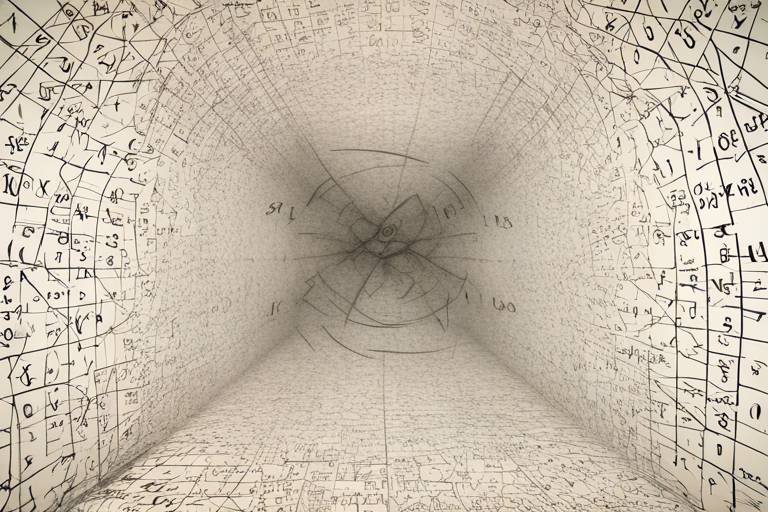Exploring the Metaphysics of Mathematics
Mathematics is often regarded as the language of the universe, a tool that helps us decode the complexities of reality. But have you ever stopped to ponder the philosophical foundations that underpin this fascinating discipline? What if the numbers and equations we manipulate are not just mere constructs of our minds but hold a deeper significance? In this article, we will embark on an exciting journey through the metaphysics of mathematics, diving into its nature, existence, and the profound implications it has on our understanding of the world around us.
The exploration begins with a fundamental question: what are mathematical objects? Are they real entities that exist independently of human thought, or are they simply figments of our imagination? To answer this, we will delve into various philosophical perspectives, shedding light on how these viewpoints shape our comprehension of mathematical concepts. Imagine standing at the edge of a vast ocean, each wave representing a different theory, and as we dive deeper, we will uncover the treasures hidden beneath the surface.
As we navigate through this philosophical sea, we encounter two prominent schools of thought: Platonism and Nominalism. Platonism suggests that mathematical entities reside in an abstract realm, waiting to be discovered, while Nominalism argues that these entities are mere linguistic and social constructs. Which perspective resonates with you? Are mathematical truths universal and timeless, or are they contingent upon human language and culture? This article will dissect these contrasting views, presenting compelling arguments for both sides.
In the following sections, we will explore the arguments supporting Platonism, highlighting the effectiveness of mathematics in describing the physical world. We will also examine the critiques of this perspective, addressing the challenges it faces in explaining the applicability of mathematics in empirical sciences. On the flip side, we will delve into the arguments for Nominalism, focusing on its rejection of abstract entities and its emphasis on the role of language in shaping mathematical thought.
Furthermore, we will investigate the crucial role of language in mathematics. Have you ever considered how the words we use influence our understanding of mathematical concepts? Language is not just a medium of communication; it shapes our thoughts and perceptions. We will analyze how mathematical language serves as a powerful tool for collaboration among mathematicians and how it impacts our perception of mathematical truth.
By the end of this exploration, you will have a richer understanding of the metaphysical questions surrounding mathematics, and perhaps, you will find yourself pondering the nature of reality itself. So, buckle up and prepare for an intellectual adventure that promises to challenge your perceptions and ignite your curiosity!
- What is the metaphysics of mathematics? The metaphysics of mathematics examines the nature and existence of mathematical entities, questioning whether they are real or merely human constructs.
- What are the main philosophical views on mathematics? The two dominant views are Platonism, which posits that mathematical entities exist in an abstract realm, and Nominalism, which denies their independent existence.
- How does language influence mathematical thought? Language shapes our understanding of mathematical concepts and impacts our perception of mathematical truth, serving as a vital tool for communication in the mathematical community.

The Nature of Mathematical Objects
The exploration of mathematical objects invites us into a realm where the boundaries of reality and abstraction blur. Have you ever wondered if numbers, shapes, and functions exist independently of our minds, or are they mere constructs we’ve created to make sense of the world? This question lies at the heart of the philosophical debate surrounding the nature of mathematical objects. Are they like ghosts that haunt the corridors of our thoughts, or are they tangible entities waiting to be discovered in the fabric of the universe?
To dive deeper, we must consider various philosophical perspectives that provide insight into the existence and nature of these mathematical entities. One perspective is that of realism, which posits that mathematical objects exist in an abstract realm, much like the way we perceive physical objects in our world. In contrast, there’s the view of constructivism, which suggests that mathematical objects are merely constructs of human thought, shaped by our language and cultural contexts. This leads us to ponder: if mathematical objects are constructs, what does that say about our ability to understand and describe the universe?
Many philosophers have attempted to categorize mathematical objects into distinct types. For instance, we can think of them in terms of:
- Abstract entities: Numbers, sets, and functions that exist in a theoretical framework.
- Concrete representations: Physical manifestations of mathematical concepts, such as geometric shapes or graphs.
- Symbols and language: The notation and terminology we use to communicate mathematical ideas.
Consider the number 3. Is it merely a symbol we use to represent a quantity, or does it possess an existence of its own? This question leads to a fascinating discussion about the ontological status of mathematical objects. Some argue that numbers are simply tools for counting and measuring, while others contend that they exist in a realm of their own, independent of human thought.
Furthermore, the implications of these philosophical views extend beyond mere academic debate. They influence how we approach mathematics in practical applications, from engineering to economics. If we view mathematical objects as real entities, we might be more inclined to trust their predictive power in modeling natural phenomena. Conversely, if we see them as constructs, we might approach mathematical modeling with a more critical eye, questioning the assumptions and limitations inherent in our representations.
In conclusion, the nature of mathematical objects is a complex and multifaceted topic that challenges our understanding of existence itself. As we navigate through these philosophical waters, we must remain open to the idea that our perceptions of mathematical reality may be as varied as the objects we seek to define. So, next time you encounter a mathematical concept, take a moment to reflect on its nature. Is it just a figment of our imagination, or does it hold a deeper significance in the grand tapestry of reality?
- What are mathematical objects? Mathematical objects are entities such as numbers, shapes, and functions that are used in mathematical reasoning and problem-solving.
- Do mathematical objects exist independently of human thought? This is a subject of philosophical debate; some believe they exist in an abstract realm, while others argue they are constructs of human cognition.
- How do different philosophical views influence the understanding of mathematics? Different perspectives, such as realism and constructivism, shape how we approach mathematical concepts and their applications in the real world.

Platonism vs. Nominalism
When we dive into the philosophical waters of mathematics, we encounter two dominant schools of thought: Platonism and Nominalism. These perspectives offer contrasting views on the existence and nature of mathematical entities, and understanding them can significantly enhance our grasp of mathematical concepts. So, what exactly do these terms mean? Platonism suggests that mathematical objects exist independently in an abstract realm, much like a hidden treasure waiting to be discovered. On the other hand, Nominalism argues that these entities are mere labels we use to describe collections of objects or concepts, akin to the names we give to colors in a crayon box.
To further clarify, let’s break down the core differences between these philosophies:
| Aspect | Platonism | Nominalism |
|---|---|---|
| Existence of Mathematical Objects | Exist independently in an abstract realm | Do not exist independently; are constructs of language |
| Nature of Mathematical Truth | Truths are discovered | Truths are created through language and social agreement |
| Applicability to the Physical World | Mathematics describes the universe's structure | Mathematics is a tool for communication and understanding |
Now, let's delve deeper into each perspective. Supporters of Platonism argue that mathematical truths are universal and timeless, much like the laws of physics. They believe that when mathematicians prove a theorem, they are not creating something new but rather revealing a pre-existing truth. This notion raises an intriguing question: if mathematical truths exist in an abstract realm, how do we access them? Platonists often liken this process to exploring a vast library of knowledge, where each mathematical concept is a book waiting to be read.
Conversely, Nominalists challenge this view by emphasizing the role of language and social constructs in shaping our understanding of mathematics. They argue that mathematics is a human invention, a sophisticated language we use to communicate ideas about quantities, shapes, and patterns. In this sense, mathematical entities are like characters in a story, brought to life through our collective imagination and discourse. For Nominalists, the focus lies not on discovering abstract truths but rather on how we use language to articulate our understanding of the world.
This philosophical debate doesn't merely exist in the realm of academia; it has profound implications for how we teach and learn mathematics. For instance, if we embrace a Platonist view, we might focus on uncovering mathematical truths through exploration and discovery. However, a Nominalist approach could lead us to emphasize the importance of language and context in understanding mathematical concepts, fostering a more collaborative and communicative learning environment.
Ultimately, the discussion between Platonism and Nominalism is not just an academic exercise; it reflects our ongoing quest to understand the nature of reality itself. Are we uncovering universal truths, or are we constructing our understanding through shared language and experiences? This philosophical inquiry invites us to reflect on our own beliefs about mathematics and its role in our lives.

Arguments for Platonism
Platonism presents a compelling case for the existence of mathematical objects in an abstract realm, independent of human thought. One of the core arguments supporting Platonism is the notion of mathematical truth. This idea suggests that mathematical statements can be either true or false, regardless of whether anyone is around to contemplate them. For instance, the statement "2 + 2 4" holds true universally, transcending time and human perception. This universality implies that mathematical truths are not merely subjective opinions but rather objective realities that exist in a realm of their own.
Another intriguing aspect of Platonism is the effectiveness of mathematics in describing the physical world. Consider how mathematics serves as the language of the universe. From the intricate patterns of nature to the laws of physics, mathematical concepts provide a framework that allows us to make sense of complex phenomena. Think about how engineers rely on mathematical principles to design bridges or how physicists use equations to describe the motion of planets. This effectiveness raises the question: how can something so abstract and seemingly disconnected from the tangible world be so adept at explaining it? Platonists argue that this efficacy is a strong indicator of the existence of mathematical entities in an abstract realm.
Moreover, the philosophical implications of Platonism extend beyond mere existence; they touch upon the nature of understanding itself. If mathematical entities exist independently, it suggests that our understanding of mathematics is less about creating knowledge and more about discovering it. This perspective aligns with the notion of mathematical realism, where mathematicians are viewed as explorers uncovering truths that already exist, much like archaeologists digging for ancient artifacts. This discovery model contrasts sharply with the Nominalist view, which posits that mathematical concepts are merely linguistic constructs.
To further illustrate the arguments for Platonism, consider the following table that summarizes the key points:
| Argument | Description |
|---|---|
| Mathematical Truth | Mathematical statements are objectively true or false, independent of human thought. |
| Effectiveness in Science | Mathematics effectively describes and predicts natural phenomena, suggesting an abstract existence. |
| Discovery vs. Invention | Mathematics is a discovery of existing truths rather than a human invention. |
In conclusion, the arguments for Platonism provide a fascinating lens through which we can view the world of mathematics. They challenge us to think deeply about the nature of reality and the role that abstract entities play in our understanding of the universe. If mathematics is indeed a reflection of an abstract realm, it opens up a world of possibilities for how we perceive and interact with the reality around us.
- What is Platonism in mathematics? Platonism is the philosophical view that mathematical entities exist independently of human thought in an abstract realm.
- How does Platonism explain the effectiveness of mathematics? Platonists argue that the success of mathematics in describing the physical world indicates the existence of mathematical truths that are independent of human perception.
- What is the difference between Platonism and Nominalism? Platonism asserts the existence of abstract mathematical entities, while Nominalism denies their independent existence, viewing mathematics as a social construct.

Mathematics and Reality
When we think about mathematics, it often feels like we’re diving into an abstract universe filled with numbers, shapes, and equations that exist independently of our physical world. But what if I told you that mathematics is not just a set of abstract concepts but a powerful tool that helps us understand the very fabric of reality? It’s like having a map that guides us through the complex terrain of the universe, revealing connections and truths that are otherwise hidden from plain sight.
At its core, mathematics serves as a language of the universe. Just as words can describe emotions, mathematics describes relationships and patterns in nature. For instance, consider the Fibonacci sequence, which appears in various forms in nature, from the arrangement of leaves to the spirals of shells. This isn’t just coincidence; it highlights how deeply intertwined mathematics is with the world around us. The mathematical structures we study can often be seen mirrored in the natural world, suggesting that there is an inherent order to the chaos of existence.
Moreover, the effectiveness of mathematics in the sciences is simply astonishing. It provides the framework for everything from physics to engineering. Think about it: how can we predict the trajectory of a rocket or the behavior of particles at the quantum level without the rigorous application of mathematical principles? This effectiveness raises profound questions about the nature of reality itself. Is mathematics merely a human invention, or does it exist in some abstract realm that governs the universe?
To illustrate this connection, consider the following table that outlines some of the key mathematical concepts and their corresponding physical phenomena:
| Mathematical Concept | Physical Phenomenon |
|---|---|
| Calculus | Motion and Change |
| Geometry | Shapes and Space |
| Probability | Statistical Mechanics |
| Group Theory | Symmetries in Physics |
This table highlights just a few instances where mathematical concepts have profound implications for our understanding of reality. Each entry not only showcases the utility of mathematics but also invites us to ponder whether these concepts exist independently of our minds or are simply tools we've developed to make sense of our observations.
Furthermore, the beauty of mathematics lies in its ability to describe phenomena that are otherwise intangible. Take the concept of infinity, for example. It’s a concept that stretches our understanding of reality, challenging our perceptions of what is finite and what is limitless. In many ways, mathematics acts as a bridge between the known and the unknown, allowing us to explore the depths of the universe while grappling with the limitations of human comprehension.
In conclusion, the relationship between mathematics and reality is not just a philosophical debate; it is an ongoing exploration of how we understand the universe. Whether viewed through the lens of Platonism or Nominalism, one thing remains clear: mathematics is more than mere numbers and symbols. It is a vital part of our quest to comprehend the intricate tapestry of existence itself.
- What is the significance of mathematics in understanding reality? Mathematics provides a framework for analyzing and interpreting the natural world, allowing us to uncover patterns and relationships that inform our understanding of physical phenomena.
- Are mathematical concepts invented or discovered? This is a matter of philosophical debate. Some argue that mathematical concepts exist independently of human thought (discovered), while others believe they are human constructs (invented).
- How does mathematics apply to the sciences? Mathematics is essential in the sciences as it enables precise modeling, predictions, and analysis of various phenomena, from the motion of celestial bodies to the behavior of subatomic particles.

Critiques of Platonism
While Platonism offers a compelling vision of mathematics as a realm of abstract entities, it is not without its critics. One of the most significant challenges to Platonism is the problem of access. If mathematical objects exist in a non-physical, abstract realm, how do we as human beings access this realm? This question raises profound implications about the nature of knowledge and understanding. Are mathematicians merely discovering truths that already exist, or are they creating them through their intellectual endeavors? This dilemma leads to a philosophical quandary that Platonists must grapple with.
Another critique centers around the applicability of mathematics in the empirical sciences. Critics argue that if mathematical entities exist independently of the physical world, it becomes difficult to explain how these abstract concepts can accurately describe the intricacies of our tangible universe. For instance, consider the mathematical model used to predict the trajectory of a rocket. Does the success of this model imply that the abstract entities it employs have some form of existence in the physical realm? Or is it simply a testament to the human mind's ability to construct useful tools for understanding reality?
Moreover, Nominalists challenge the very existence of abstract entities, arguing that mathematical truths are merely linguistic constructs. They contend that when we speak of numbers or geometric shapes, we are not referring to entities that exist independently but rather to symbols and concepts that serve specific purposes in communication and understanding. This perspective shifts the focus from the existence of mathematical objects to the social and linguistic frameworks that shape our mathematical discourse.
Additionally, the notion of mathematical truth comes under scrutiny. Platonists assert that mathematical truths are eternal and unchanging, residing in the abstract realm. However, critics argue that this view does not account for the evolution of mathematical thought over time. For example, concepts that were once considered true, such as Euclidean geometry, have been challenged and expanded upon by non-Euclidean frameworks. This evolution suggests that mathematical truths may not be as absolute as Platonists claim, raising questions about the nature of reality itself.
In summary, critiques of Platonism highlight significant philosophical challenges regarding the existence of abstract entities, the applicability of mathematics, and the nature of mathematical truth. These debates invite us to ponder deeper questions about the relationship between mathematics and reality. Are we merely observers of an abstract world, or are we active participants in creating the mathematical structures that help us navigate our universe?
- What is Platonism in mathematics? Platonism is the philosophical view that mathematical entities exist independently of human thought, in an abstract realm.
- What are the main critiques of Platonism? The main critiques include the problem of access to abstract entities, the challenge of explaining the applicability of mathematics in empirical sciences, and the evolution of mathematical truths.
- How does Nominalism differ from Platonism? Nominalism denies the independent existence of mathematical entities, viewing them as social and linguistic constructs instead.
- Why is the nature of mathematical truth debated? The debate arises from differing views on whether mathematical truths are eternal and unchanging or subject to evolution and interpretation over time.

Arguments for Nominalism
Nominalism presents a compelling counter-narrative to the abstract existence of mathematical entities championed by Platonism. At its core, nominalism asserts that mathematical objects do not exist independently of our thoughts and language; instead, they are mere linguistic constructs or social agreements. This perspective invites us to reconsider how we understand mathematical truths. After all, if numbers and shapes are just names we’ve given to concepts, how does that change our relationship with mathematics?
One of the key arguments for nominalism is the rejection of abstract entities. Nominalists argue that when we speak of numbers or geometric figures, we are not referring to something that exists outside of our minds. Instead, these terms are simply labels we use to describe certain patterns and relationships in the world. For instance, when we say “three,” we are not pointing to an abstract “three-ness” floating in some metaphysical realm; we are identifying a quantity that can be observed in the physical world, such as three apples on a table.
Furthermore, nominalism emphasizes the role of language in shaping our mathematical understanding. The way we communicate mathematical ideas is deeply intertwined with the language we use. For example, consider the difference between how we express mathematical concepts in English versus another language. This variation can influence how we think about and approach mathematics. The nominalist viewpoint suggests that our mathematical truths are not universal absolutes but rather contingent on the linguistic frameworks we employ.
Another compelling argument for nominalism lies in its ability to explain the applicability of mathematics in the empirical sciences. Nominalists contend that mathematics serves as a tool for describing the world rather than a discovery of pre-existing truths. This perspective aligns with the pragmatic view of mathematics, where the focus is on its usefulness in solving real-world problems. For instance, engineers and scientists utilize mathematical models to predict outcomes and analyze data without needing to posit the existence of abstract entities.
Critics of nominalism often question how we can have meaningful discussions about mathematical concepts if they are merely constructs. However, nominalists counter that the shared understanding of these constructs allows for effective communication and collaboration in mathematics. The very act of using mathematical language creates a framework within which we can engage in discourse, solve problems, and advance knowledge. In this way, nominalism does not diminish the significance of mathematics; rather, it highlights the importance of our collective agreement on the meanings of mathematical terms.
In summary, the arguments for nominalism challenge us to rethink our assumptions about the nature of mathematics. By emphasizing the role of language and social constructs, nominalism presents a view that is not only philosophically intriguing but also practically relevant in our daily lives. It prompts us to ask ourselves: Are we merely naming the patterns we see in the world, or is there something more profound at play? As we continue to explore the metaphysics of mathematics, the debate between nominalism and Platonism remains a fascinating and vital discussion.
- What is nominalism in mathematics? Nominalism is the philosophical view that mathematical objects do not exist independently of our thoughts and language; they are constructs or labels we use to describe relationships and patterns.
- How does nominalism differ from Platonism? While Platonism posits that mathematical entities exist in an abstract realm, nominalism denies their independent existence, arguing that they are social constructs shaped by language.
- Why is language important in understanding mathematics? Language shapes our mathematical thought and communication, influencing how we perceive and discuss mathematical concepts.
- Can nominalism explain the success of mathematics in science? Yes, nominalism suggests that mathematics is a useful tool for describing the world, rather than a discovery of pre-existing truths.

The Role of Language in Mathematics
The relationship between language and mathematics is a fascinating topic that often goes unnoticed. Just imagine trying to communicate the intricacies of mathematical theories without a common language; it would be akin to navigating a maze blindfolded. Language serves as the bridge that connects abstract mathematical concepts to tangible understanding. It shapes not only how we express mathematical ideas but also how we perceive and comprehend them. This is crucial because mathematics is not just a set of numbers and symbols; it is a language in its own right, rich with syntax and semantics.
Moreover, the language of mathematics is universal, transcending cultural and linguistic barriers. When mathematicians from different parts of the world gather, they can communicate through the shared symbols and terminologies of mathematics. This shared language enables collaboration and innovation, pushing the boundaries of what we know. For instance, consider how equations and formulas can convey complex ideas succinctly. A single equation can encapsulate a multitude of concepts, making it easier to communicate intricate theories.
However, the role of language in mathematics extends beyond mere communication. It influences our thought processes. The way we phrase a problem can significantly impact our approach to solving it. For example, consider the difference between asking, “What is the area of this shape?” versus “How can we maximize the area of this shape?” The first question prompts a straightforward calculation, while the second invites a more analytical and strategic mindset. This illustrates how language can shape our mathematical thinking and problem-solving strategies.
It's also essential to recognize that mathematical language isn't static. It evolves, reflecting changes in mathematical thought and societal needs. New terminologies are coined, and existing ones are redefined as we discover more about the universe. This dynamic nature of mathematical language is what keeps it vibrant and relevant. Just as languages in human cultures adapt to new realities, so does the language of mathematics.
In this context, we can also consider the impact of language on mathematical truth. Does a mathematical truth exist independently of the language used to express it? This question invites us to ponder the very nature of mathematical reality. Some argue that truths are universal and can be understood regardless of the language, while others contend that the language we use shapes our understanding of these truths. This debate is not just academic; it has profound implications for how we teach and learn mathematics.
To illustrate this point, let’s take a look at how different languages express mathematical concepts. For example, in English, we might say, "The sum of two and three is five." In other languages, the structure of the sentence may differ, yet the underlying mathematical truth remains the same. However, the way these concepts are taught and understood can vary significantly based on linguistic nuances.
| Language | Expression of Mathematical Truth |
|---|---|
| English | The sum of two and three is five. |
| Spanish | La suma de dos y tres es cinco. |
| French | La somme de deux et trois est cinq. |
| German | Die Summe von zwei und drei ist fünf. |
As we delve deeper into the philosophy of mathematics, we realize that the role of language is not just about communication or expression; it’s about shaping our understanding of the world. The interplay between language and mathematics is a reminder of how intertwined our thoughts, cultures, and knowledge truly are. Just like a painter uses brushes and colors to create a masterpiece, mathematicians use language to paint the canvas of reality with their theories and discoveries.
- How does language influence mathematical understanding? Language shapes the way we think about and approach mathematical problems, affecting our problem-solving strategies.
- Is mathematical truth universal? While many believe that mathematical truths are universal, the language used to express them can influence our understanding and interpretation.
- Can mathematics exist without language? Mathematics as a concept can exist independently, but our ability to communicate and understand it relies heavily on language.

Mathematical Language and Communication
Mathematics is often perceived as a universal language, transcending borders and cultures. But what does that really mean? When we talk about mathematical language, we’re not just referring to symbols and numbers; we’re diving into a rich tapestry of communication that connects mathematicians across the globe. Just like a musician uses notes to create a symphony, mathematicians utilize symbols and terms to express complex ideas. This language is essential for sharing knowledge, collaborating on problems, and building upon one another’s work.
In the world of mathematics, clarity and precision are paramount. Consider how a single misinterpretation of a symbol can lead to vastly different conclusions. For instance, the difference between the symbols “+” and “-” can change a solution from a positive outcome to a negative one. This highlights the importance of a shared understanding of mathematical language among mathematicians.
Moreover, mathematical language serves as a bridge between abstract concepts and real-world applications. For example, when physicists describe the laws of motion, they rely heavily on mathematical equations. These equations not only communicate the relationships between variables but also facilitate predictions about physical phenomena. Imagine trying to explain the trajectory of a rocket without the precise language of calculus!
One fascinating aspect of mathematical communication is how it evolves. Just like any language, mathematical language adapts to new discoveries and technologies. Terms like “algorithm” and “data science” have become commonplace in recent years, reflecting the changing landscape of mathematics in the digital age. This evolution raises interesting questions: How does the introduction of new terminology affect our understanding of existing concepts? Are we at risk of losing the essence of mathematical ideas as we continuously innovate?
In academic circles, the communication of mathematical ideas often takes place through journals, conferences, and collaborative projects. These platforms allow mathematicians to present their findings, critique others’ work, and engage in discussions that drive the field forward. However, the language used in these settings can sometimes be daunting, filled with jargon that may alienate newcomers. This brings us to a critical point: how do we make mathematical communication more accessible?
To enhance accessibility, educators and mathematicians are increasingly focusing on the importance of teaching mathematical language effectively. By breaking down complex ideas into simpler terms and using relatable analogies, we can foster a deeper understanding among students. For instance, comparing mathematical functions to recipes can help illustrate how different ingredients (variables) come together to create a final dish (output).
Ultimately, the role of language in mathematics is not just about communication; it’s about connection. It’s about fostering a community where ideas can flourish and where individuals can collaborate to solve problems that impact our world. As we continue to explore the metaphysics of mathematics, let’s not forget the powerful role that language plays in shaping our understanding and appreciation of this beautiful discipline.
- What is mathematical language?
Mathematical language refers to the symbols, terms, and structures used to express mathematical ideas and concepts. It serves as a medium for communication among mathematicians and helps convey complex ideas clearly and precisely.
- Why is clarity important in mathematical communication?
Clarity is crucial because a misunderstanding of symbols or terms can lead to incorrect conclusions. Precise language ensures that ideas are conveyed accurately, allowing for effective collaboration and knowledge sharing.
- How does mathematical language evolve?
Mathematical language evolves as new discoveries are made and as the field adapts to technological advancements. New terms and symbols emerge, reflecting changes in the way mathematics is applied in various domains.
- What can be done to make mathematical communication more accessible?
To improve accessibility, educators can focus on breaking down complex concepts into simpler terms, using relatable analogies, and encouraging open discussions that welcome diverse perspectives.

Language and Mathematical Truth
When we dive into the intricate relationship between language and mathematical truth, it's like peeling back the layers of an onion—each layer revealing more about how we understand the universe. At first glance, one might think that mathematics is a universal language, transcending cultures and linguistic barriers. However, the reality is far more nuanced. The language we use to express mathematical ideas can significantly influence our perception of mathematical truths. For instance, consider how different cultures might have unique ways of describing the same mathematical concepts. This raises an intriguing question: do mathematical truths exist independently of the language we use to express them?
To explore this, we need to consider the implications of mathematical language on our understanding of truth. Some philosophers argue that mathematical truths are absolute and exist in a realm of their own, independent of human expression. Others, however, suggest that these truths are contingent upon the linguistic frameworks we use. For example, the way we phrase a mathematical statement can alter its interpretation. A simple equation like 2 + 2 4 is universally accepted, yet the way we articulate the concepts of 'two', 'addition', and 'equals' can vary widely across languages. This leads us to ponder: does the essence of mathematical truth change with language, or is it merely our understanding that shifts?
Furthermore, the structure of language itself can shape mathematical thought. The grammatical frameworks and vocabulary available in a given language can either limit or expand the ways we conceptualize mathematical ideas. For instance, languages that have specific terms for different types of infinity might enable speakers to grasp complex mathematical concepts more readily than those without such distinctions. This brings us to the idea of linguistic relativity, which suggests that the language we speak influences the way we think. In this context, one could argue that our understanding of mathematical truth is not just a matter of logic and reasoning, but also a product of the linguistic tools at our disposal.
In the realm of mathematics, communication is key. The mathematical community relies heavily on a shared language to convey complex ideas. The clarity and precision of this language can determine how effectively a concept is understood. For example, consider the difference between a mathematical proof presented in a straightforward manner versus one laden with ambiguous terminology. The former is likely to be grasped more readily, while the latter may lead to confusion and misinterpretation. This highlights the importance of clear communication in mathematics and suggests that the truth of a mathematical statement can sometimes be obscured by the language used to express it.
Ultimately, the interplay between language and mathematical truth invites us to reconsider our assumptions. Are we merely uncovering eternal truths, or are we actively constructing our understanding of mathematics through the language we use? The answer may not be straightforward, but it's a question worth pondering. As we continue to explore these complexities, we might find that our grasp of mathematical truths is deeply intertwined with the linguistic structures that shape our thoughts.
- What is the relationship between language and mathematical truth?
Language can influence how we perceive and understand mathematical truths, shaping our interpretations and conceptualizations. - Can mathematical truths exist independently of language?
This is a debated topic; some argue that mathematical truths are absolute, while others believe they are contingent upon linguistic expression. - How does linguistic relativity affect mathematical understanding?
Linguistic relativity suggests that the structure and vocabulary of a language can impact how speakers conceptualize and reason about mathematical ideas. - Why is communication important in mathematics?
Clear and precise communication is essential in mathematics to ensure that complex ideas are understood correctly and to facilitate collaboration within the mathematical community.
Frequently Asked Questions
- What are mathematical objects?
Mathematical objects are entities like numbers, shapes, and functions that we use in mathematics. The debate revolves around whether these objects exist independently of human thought or if they are merely constructs of our minds. This philosophical inquiry dives deep into the nature of existence and reality itself.
- What is Platonism in mathematics?
Platonism is a philosophical viewpoint that suggests mathematical entities exist in an abstract realm, independent of our minds. According to Platonists, mathematical truths are discovered rather than invented, which raises fascinating questions about the nature of reality and our understanding of it.
- What are the main arguments for Nominalism?
Nominalism argues against the existence of abstract mathematical entities, positing that mathematics is a linguistic and social construct. Nominalists believe that mathematical truths are not universal but are instead tied to the language and conventions we use, making it a more subjective approach to understanding mathematics.
- How does language influence mathematical thought?
Language plays a crucial role in shaping our understanding of mathematical concepts. The way we express mathematical ideas can affect how we perceive their validity and application. This interplay between language and mathematics raises intriguing questions about the nature of mathematical truth and its dependence on linguistic structures.
- Can mathematics describe reality?
Yes, many argue that mathematics serves as a powerful tool for describing and understanding the physical world. Concepts such as geometry and calculus provide frameworks that help us model natural phenomena, suggesting a deep connection between mathematical theory and the universe's structure.
- What are the critiques of Platonism?
Critiques of Platonism often focus on the challenges of accessing abstract entities and explaining how mathematics applies to empirical sciences. Critics argue that if mathematical entities exist in an abstract realm, it becomes problematic to understand how we can interact with or utilize them in the tangible world.



















